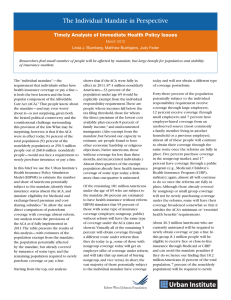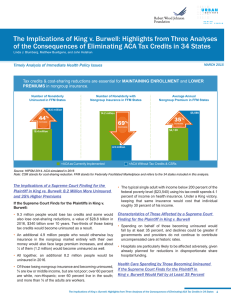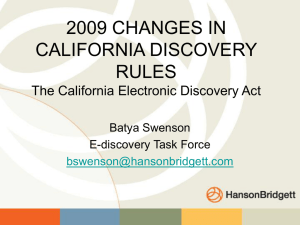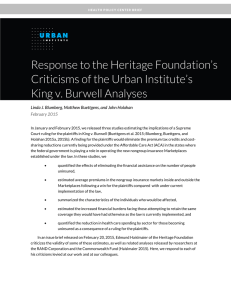Gruber presentation - Connect for Health Colorado
advertisement
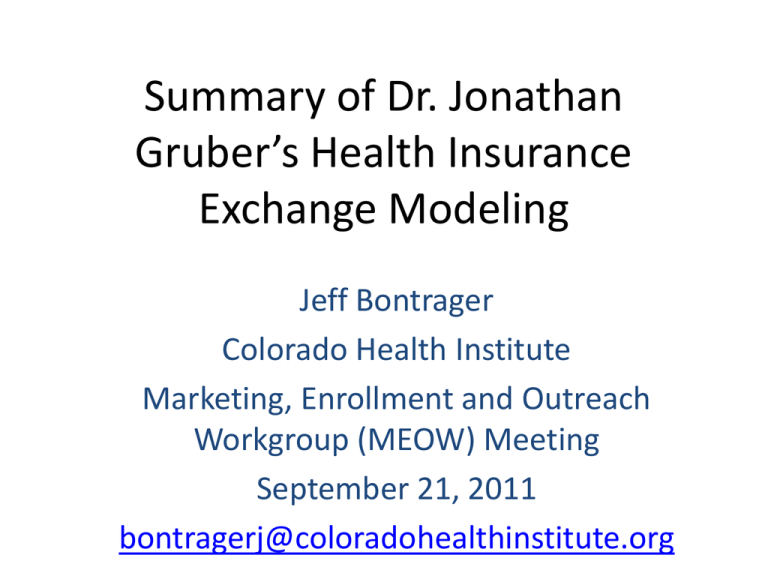
Summary of Dr. Jonathan Gruber’s Health Insurance Exchange Modeling Jeff Bontrager Colorado Health Institute Marketing, Enrollment and Outreach Workgroup (MEOW) Meeting September 21, 2011 bontragerj@coloradohealthinstitute.org Background and caveats • This presentation was given by Dr. Jonathan Gruber from MIT to the Colorado Health Benefit Exchange Board on Sept 16, 2011 • Data source is the 2008-09 Colorado Household Survey and the Gruber Microsimulation Model • All numbers are estimates, limited to ages 0-64 • The final report, including narrative, methods and assumptions, is planned for release within the next month Table 1: Colorado Enrollments Insurance Category 2011 % of population Employer-Sponsored Insurance (ESI) 2,650,000 62.3% Small Firm ESI (1-50 employees) 570,000 13.4% 2,080,000 49.0% Individual Market Insurance 310,000 7.2% Public Insurance 440,000 10.3% Uninsured 850,000 20.1% Large Group ESI Table 2: Estimate of ACA Effect, 2016 No Reform With ACA ACA Impact 2,630,000 2,600,000 -30,000 Small Firm ESI (1-50 employees) 560,000 540,000 -20,000 Other ESI 2,070,000 2,060,000 -10,000 Unreformed Non-group 340,000 60,000 -280,000 Reformed Non-group 0 620,000 620,000 Tax Credit Recipients 0 470,000 470,000 Non-Recipients 0 150,000 150,000 Public Insurance 550,000 710,000 160,000 Uninsured 860,000 400,000 -460,000 Total 4,390,000 4,390,000 ESI Table 3: Summary of Previously Uninsured, 2016 Post-ACA Adult females 1944 Adult females 4564 Adult males 19-44 Adult males 45-64 Children Ages 0-18 39,000 21,000 41,000 11,000 19,000 Reformed or 30,000 Unreformed Non-group 41,000 72,000 40,000 29,000 Employer Sponsored Insurance 38,000 12,000 53,000 17,000 36,000 Total Newly Insured 111,000 74,000 170,000 68,000 85,000 Remaining Uninsured 90,000 43,000 88,000 49,000 84,000 Baseline Uninsured 202,000 117,000 259,000 116,000 170,000 Medicaid/C HP+ Table 4: Movements due to ACA: 2016 Ex-ante ESI ESI Ex-Post Nongroup Public Uninsured Total 2,440,000 - - 160,000 2,600,000 Reformed or Unreformed Nongroup 130,000 330,000 0 220,000 680,000 Public 30,000 - 550,000 130,000 710,000 Uninsured 40,000 - 0 350,000 400,000 2,630,000 330,000 550,000 860,000 4,390,000 Total Note: “-” indicates a movement that is less than 10,000 but greater than 0. Table 5: Reformed Market Participation and Tax Credit Uptake: 2016 # of individuals Cumulative # of individuals Tax credit recipients in 470,000 individual reformed market - Employees (& dependents) 120,000 of firms receiving tax credit 590,000 Non-tax credit recipients in 150,000 individual reformed market 740,000 Employees (& dependents) 420,000 of non-tax credit firms with <50 employees 1,160,000 Table 6: Premiums and Actuarial Values for those Remaining on Nongroup: 2016 Ex-Ante Ex-Post (No Subsidies) Ex-Post (With Subsidies) Average Nongroup Premium $5,580 $6,610 $4,060 Average Nongroup Actuarial Value .608 .676 .675 Note: The changes in this table do not reflect removal of pre-existing conclusions restrictions, reuse of any funds that fund the high risk pool (which is now folded into the reformed market), or reinsurance/risk adjustment/risk corridor mechanisms. Figure 19: Nongroup Premium Changes (including tax credits) for those Remaining on Nongroup: 2016 5% 0% 5% <-50% 34% 14% -50% to -25% -25% to -10% -10% to 0% 0% 0% to 10% 10% to 25% 18% 25% to 50% 11% 6% 7% >50% Table 7: Household Budget Effects: 2016 Status Quo (in billions) After ACA (in billions) ACA Effect (in billions) Per Household Effect $162.1 $162.4 $0.3 $130 Exchange Credits $0.0 $1.0 $1.0 $440 Public Insurance $0.6 $0.6 $270 $1.9 $840 Wages $0.0 Additional Benefits ESI Contribution $4.0 $3.8 -$0.2 -$90 Non-group Premium $1.8 $1.8 $0.0 $0 OOP Spending $2.6 $2.4 -$0.2 -$90 Taxes $37.0 $37.4 $0.4 $180 Additional Costs $0.0 $0 Net Effects $1.9 $840 $1,500* $1,150*
